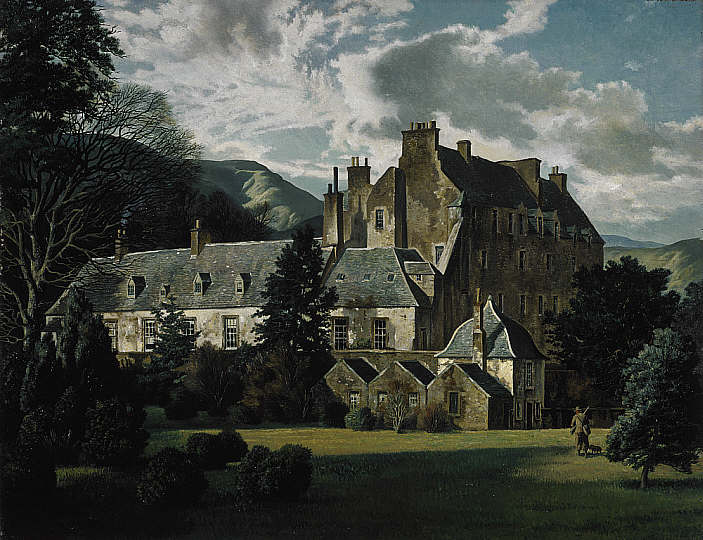Picture Gallery
Paxton House, Berwick-upon-Tweed
Curved Stream
Traquair House, Innerleithen, until 31 October
In the Regency picture gallery at Paxton House hangs a full-length portrait of a young man in striking yellow breeches. The horse at his side is rubbing its bridle on its knee, the way horses do, while the man looks out at the viewer with the composed confidence of a fellow who would go on to be professor of moral philosophy at the University of Edinburgh.
This is John Wilson, or ‘Christopher North’, writer, critic, advocate and, according to one contemporary, nothing less than ‘a true upright, knocking-down, poetical, prosaic, moral, professional, hard-drinking, fierce eating, good-looking, honorable and straightforward Tory.’ The painting is one of several at Paxton by the great portraitist Sir Henry Raeburn, and it looks splendid and appropriate hanging here in Scotland’s largest private gallery. The freshly rehung exhibition comprises more than thirty works on loan from the National Galleries of Scotland with whom Paxton has enjoyed partner status since 1992.
We are not short of Raeburn portraits in Scotland but it is impossible to tire of his work. His sitters are solid characters with glinting eyes, rendered with bold economy of brushwork. Christopher North is presented as the gallant sportsman, just dismounted from his gleaming horse. While his face is handled with delicacy, the outer reaches are applied with an almost sketchy simplicity. This is typical of Raeburn. Areas of flat tone are enlivened by single stroke highlights that lend the painting energy and vivid light.
From the wall opposite steps the 4th Marchioness of Lothian, moving across a bleak, stage-like landscape in a scarlet satin dress while plucking a guitar. It is a striking and peculiar painting from around 1750, by Joseph Anton Adolf. Curious paintings abound at Paxton. Above a door, quite hard to see, is a dark little depiction of a curling match. Dismissed as a copy of a similar scene by George Harvey, this is nevertheless a splendid image, with all the vibrancy and tension of any great sporting occasion translated to a frozen fogbound landscape where arms raised to urge on curling stones are mimicked by the bare branches of blasted trees in the background.
Bleak landscapes are common here too. William Gillies’ ‘The Train From Peebles’ shows the great round hills of the western Borders, quartered by the graphic lines of plough and drystane dyke, and interrupted by a train and its soft white puffs of steam. The Gillies painting is part of the new collection of 20th Century pieces on display. These offer a foil to the sheer romanticism of the earlier landscapes from the glowering palettes of John Crawford Wintour or the Reverend John Thompson. Wintour’s ‘A Border Castle’ is so romanticized that the man who commissioned it refused to accept it. Here it lurks, still unrecognizable as Ayton Castle.
Among the modern paintings, near the obligatory Colourists Peploe and Hunter, is a rich little William McTaggart seascape, ‘Quiet Sunset, Macrihanish’. A small masterpiece, this captures that mellow light, typical of a west coast evening, which forces itself through low cloud, illuminating the shifting, shimmering sea surface. It is a glorious little painting that deserves to be hung in better view. More favourably positioned are two lively Anne Redpath still lives that illustrate her shift towards an ever more abstracted expressionism. Born nearby in Galashiels, Redpath remains one of the greatest Borders artists.
Eight contemporary artists from the Borders and beyond are exhibiting this autumn at Traquair House, a salmon’s swim up the Tweed from Paxton. The oldest inhabited house in Scotland, Traquair is a fascinating place where a cradle that once rocked the infant James VI & I can be seen alongside a tiny shoe belonging to his mother, Mary Queen of Scots. Dotted around the venerable exhibits within the house and grounds are the site-specific artworks of ‘Curved Stream’.
In a stone garden pavilion above a beech maze, a multicoloured strip of wood, placed above a lintel by Gordon Brennan, communicates with the 18th-century ceiling painting of Diana and Actaeon in the middle of the room. Seen together, the pigments on the strip have the effect of enhancing the hues in the painting, highlighting this subtle work of art.
Subtlety is the theme throughout, with some works so subtly placed as to be easily missed; look out for Paul Keir’s abstract panels hiding on telegraph poles asking to be mistaken for a mysterious telecom sign, and other works nestling down by the river. Mary Morrison and Andrew Mackenzie both show delicate and graceful works relating to Traquair’s history while Mark Haddon’s drawings and stepped sculptural pieces are understated offerings which contrast with the complexity around and leave much to the imagination. This is an exhibition that invites reflection and nudges the viewer toward a different appreciation of the Traquair environment. The professor of moral philosophy would have approved.









Comments